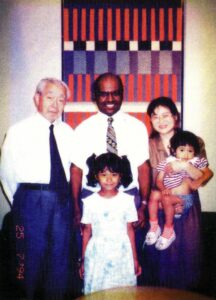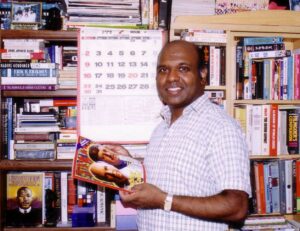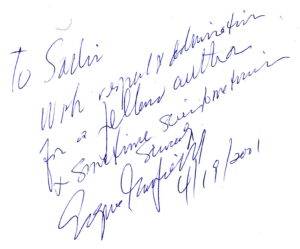Andy Rooney’s influence on my letter writing
by Sachi Sri Kantha, October 9, 2023
I consider Andy Rooney (1919 – 2011), one of my favorite humorists, as a teacher in English writing for me. Twelve years had passed since his death on Nov 4, 2011. Rooney warned prophetically in one of his columns in early 1980s, ‘The time is coming when the letter written with pen and ink and sent as a personal message from one person to another will be as much of a rarity as the gold pocket watch carried on a chain. It’s a shame.’
This particular column had an unusual influence on me, since 1983. With the onset of internet and extensive email use since late 1990s, Andy Rooney’s predicted time did arrive. In this rear glance view of my career as an avid letter writing scientist, I collect together 15 letters (from 1976 to 2012) I had received from 10 eminent scientists of the 20th century, belonging to varied disciplines. For digital record, I provide these in a pdf format nearby.
15 letters Sachi had received from Scientists (1976-2012)
Among the 10 scientists who had written letters to me, eight were Nobel Prize laureates in sciences; I have indicated them below with an asterisk, in front of their name. Among these ten, only James Watson (b. 1928) and Roald Hoffman (b. 1937) are living now. My correspondents were, (in the chronological order of correspondence):
*Harold Urey – 1934 Nobelist in chemistry. Died in 1981.
*Subramanyan Chandrasekhar – 1983 co-Nobelist in physics. Died in 1995.
*Linus Pauling – 1954 Nobelist in chemistry and 1962 Nobelist in peace, Died in 1994.
Denis Burkitt – eponymized by ‘Burkitt’s lymphoma’. Died in 1993.
*Herbert C. Brown – 1979 co-Nobelist in chemistry,. Died in 2004.
Eugene Garfield – pioneer information scientist and scientometrician, Died in 2017.
*Kenichi Fukui – 1981 co-Nobelist in chemistry. Died in 1998.
*Roald Hoffmann – 1981 co-Nobelist in chemistry
*George A. Olah – 1994 Nobelist in chemistry. Died in 2017.
*James D. Watson – 1962 co-Nobelist in medicine or physiology

Sachi’s young family with Kenichi Fukui – at his office, July 15, 1994
Among this letter collection, only the last two (Letters 14 and 15, from James Watson) were in email format and sent as images. Unfortunately, I didn’t receive the original drafts from him, via snail mail. Letters #1 to #13 were sent to me by air-mail post. Only one (that of Roald Hoffmann) among this collection was ‘written with pen and ink’ as described by Andy Rooney. Others were typed in typewriters or word processors or computers.
Andy Rooney wrote further on the value of letters. Here are excerpts:
‘There is something special about a personal letter. It’s better than a phone call, no matter what the telephone company says. A phone call disappears into the air as soon as the receiver is put back on the hook. A good letter can last a life time.
Some of my most precious possessions are letters that have been written to me sometime in the past. I don’t have a single memorable phone call stored in a box in my attic or basement. I’ve never thrown away a good letter and, like any real treasure, I don’t even have to look at them to enjoy having them. I know I have them.’
The circumstances which elicited these letters from these ten scientists were varied. I provide a brief synopsis here. After receiving my first degree in zoology in 1976 in the B.Sc.(Special) course, I was depressed by my performance. Among a class of 8, I was placed between 6 and 8! Fifty years ago, I dreamt of doing Nobel Prize winning caliber research in Europe or America. Thus, I wrote a fan letter to Harold Urey from Colombo in 1976. To my surprise, he did respond about his thoughts on receiving the Nobel prize (Letter 1).
Ten years later, after earning a Ph.D. degree from the University of Illinois, I wrote to S. Chandrasekhar in 1986, soliciting some information about his famous uncle and 1930 Nobelist in physics, Sir C.V. Raman (Letter 2). The following year, I happened to read a hostile review of Linus Pauling’s book, ‘How to Live Longer and Feel Better’ (1986) by Fergus Clydesdale that appeared in the Food Technology journal. As I admired Pauling for his genius, flare and talent, I wrote a rebuttal to this review; it appeared in the Food Technology journal in August 1987. Then, I sent a copy of my published letter to Linus Pauling, and he was gracious to send me an acknowledgment letter (Letter 3)

Sachi, at his residence, after joining the Gifu University, July 2000
In 1989, I was at the Medical College of Pennsylvania, Philadelphia as a postdoctoral fellow. Dr. Denis Burkitt (of Burkitt’s lymphoma fame) visited that institution and delivered an enjoyable lecture which I attended. At the end of the lecture, I went and introduced myself as a Sri Lankan. Instantly, he told me about his acquaintance with famous Tamil surgeon Milroy Aserappa Paul (1900-1988) during the 2nd World War. Stimulated by Burkitt’s descriptions about his career as a physician in Africa, I wrote to him asking about any insect eating habits by the African natives he had noticed. He sent me a two line reply in an aerogram (Letter 4).
In 1992, I published a preliminary study in Medical Hypotheses journal [1992; 39: 159-163], on the scientists who had published 1,000 research papers in their careers. In this paper, I gave a humorous tag to this category of prolific scientists, as ‘Kilo Base Goliaths’ (KBGs). It was a play on the initials of the infamous Soviet era intelligence agency, KGB. Then, to solicit additional information I wrote to a few Nobelists in chemistry (Herbert C. Brown and George Olah), who had published over 1,000 papers. They kindly responded to my letters (Letters 5 and 13). In addition, Eugene Garfield and Roald Hoffmann (1981 co-Nobelist in chemistry) also contributed their critical comments on my ‘KBG’ paper (Letters 6 and 10).
In 1994, I was pre-occupied in writing my ‘magnum opus’, An Einstein Dictionary. I wrote to S. Chandrasekhar again, to request permission to include a poem, which I had seen in his book ‘Truth and Beauty’. Chandrasekhar did give me permission (Letter 7). I was also keen to have an elite scientist who could contribute a ‘foreword’ to this book. As I was living in Osaka then, such an elite scientist whom I could visit nearby was in Kyoto. He was Kenichi Fukui (1981 co-Nobelist in chemistry). When I wrote to him, expressing my interest, he was hesitant at first. His modest words were, “I am afraid that I am not a qualified person to write something about Einstein, particularly in the big reference book of him.” But, as a gentleman-scientist, Prof. Fukui left me an ‘opening’ with the words, “Still, I am interested in your book project and would be pleased to see you.” (Letter 8). I picked up on his offer, went to meet him and convinced him that he was the suitable choice to write a foreword to my book. He did consent to contribute his ‘Foreword’ to An Einstein Dictionary was published in 1996 (Letter 9). Eugene Garfield’s appreciative letters encouraged me doubly, to publish more as a sole author (Letters 11 and 12). I was so delighted to receive his Festschrift book, in 2001, with a note ‘To Sachi, With respect & admiration for a fellow author & sometime scientometrician. Sincerely, Eugene Garfield, 4/19/2001’. He was indeed one of my American mentors.

Eugene Garfield’s note to Sachi, in a gifted book – Apr 19, 2001
In 2011, I was re-reading James D. Watson’s classic memoir of his post-doctoral days in England, The Double Helix (1968). Then, I was interested in writing a review on the role played by scientific reprints as a communication tool, in the pre-digital era. In chapter 16 of his book, Watson had described how he brought the paper of John Desmond Bernal and Isidore Fankuchen on tobacco mosaic virus (TMV), published in the Journal of General Physiology. I was intrigued by the sentence Watson had written, ‘Excitedly I pilfered Bernal’s and Fankuchen’s paper from the Philosophical Library and brought it up to the lab so that Francis could inspect the TMV x-ray picture.” I was under the impression that, it could have been a reprint, Then, I thought, why not check it directly with Watson himself. Though Watson had gained an image of a brash personality, I was pleased that he responded to my query forthrightly, with his email communication, dated June 10, 2011 (Letter 14).
Subsequently, I was impressed by the self-deprecating humor sprinkled in his ‘The Double Helix’ book. Thus, I chose 13 episodes included in it, and wrote a ‘Historical Notes’ paper to the Current Science [2012; 103: 950-953] fortnightly journal. Before submission, I sent a pre-publication copy for Watson’s reading, with a cover letter in May 2012. He didn’t disappoint me. He did reply with an email on August 30, 2012 (Letter 15).
Coda
Such enhancement received from James Watson subsequently stimulated me to dig deeper into his The Double Helix memoir, and I could publish few more studies on this classic work. Check the cited references below. Previously, I had written to this site, about my single letter to futurist and science-fiction author Arthur C. Clarke (1917-2008), and his reply dated Jan 6, 1976. Those interested please check this link [https://sangam.org/2008/04/Clarke.php?uid=2875]. Annotations about my correspondence with other peer scientists since 1985 will have to wait for another day.
References
Sri Kantha S. Citations to movies in the books of James Watson: A case study. International Medical Journal, Feb 2020; 27(1): 76-78.
Sri Kantha S. Portrayal of women (excluding Rosalind Franklin) in the ‘The Double Helix’ memoir of James Watson. International Medical Journal, Oct 2023; 30(5): 279-280.
Sri Kantha S. Citations and sleep episodes in ‘The Double Helix’ (1968) memoir of James Watson. International Medical Journal, Oct 2023; 30(5): 281-282.
*****